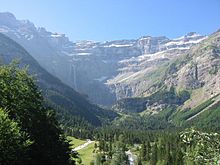Bigorre
Today Bigorre comprises the centre and west of the département of Hautes-Pyrénées, with two small exclaves in the neighbouring Pyrénées Atlantiques.
After the Battle of Vouillé (507), where the Franks defeated the Visigoths and forced them out of Aquitaine, Bigorre became part of the Frankish kingdom, usually held by the same king who controlled Toulouse.
The County of Bigorre was formed by the Dukes of Gascony in the ninth century and inherited by scions of the ducal house in the tenth.
Thereafter the Counts of Bigorre, notable participants in the Reconquista, the Crusades, and the war against the Cathars, strongly asserted their independence, though on a few occasions they prudently acknowledged the suzerainty of another; as of Alfonso II of Aragon in 1187.
Confiscated in 1292 by King Philip IV of France who intervened in a quarrel over the succession of Bigorre, the area was surrendered to Edward III of England by virtue of the Treaty of Brétigny (1360), which marked the end of the first phase of the Hundred Years' War.
Before the French Revolution, Bigorre was made part of the gouvernement (military area) of Guienne-Gascony, whereas for general matters it depended from the généralité of Auch like the rest of Gascony (although for a certain period of time it depended from the généralité of Pau, like Béarn, Nébouzan, County of Foix, and the Basque provinces).
Quatre-Vallées and Nébouzan protested vehemently against the decision, saying they wished to join with the province of Comminges with which they had historical and economic ties, but it was to no avail.
Although Tarbes is the capital of Hautes-Pyrénées, the nearby town of Lourdes has eclipsed it in fame since the apparitions of the Blessed Virgin Mary in 1858, becoming the largest modern pilgrimage center of Western Europe: 12 million people visit the religious shrines annually.



